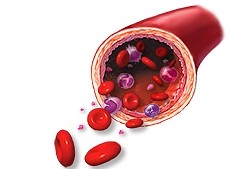Bleeding Disorders
Content
Symptoms
Exams and Tests
Treatment
Outlook (Prognosis)
Possible Complications
When to Contact a Medical Professional
Prevention
Bleeding disorders are a group of conditions in which there is a problem with the body's blood clotting process. These disorders can lead to heavy and prolonged bleeding after an injury. Bleeding can also begin on its own.
 Specific bleeding disorders include:
Specific bleeding disorders include:
· Acquired platelet function defects
· Congenital platelet function defects
· Congenital protein C or S deficiency
· Disseminated intravascular coagulation (DIC)
· Factor II deficiency
· Factor V deficiency
· Factor VII deficiency
· Factor X deficiency
· Factor XII deficiency
· Glanzmann disease
· Hemophilia A
· Hemophilia B
· Hemophilia C (Factor XI deficiency)
· Idiopathic thrombocytopenic purpura (ITP)
· Von Willebrand's disease (types I, II, and III)
·
Normal blood clotting involves blood components called platelets and as many as 20 different plasma proteins. These are known as blood clotting or coagulation factors. These factors interact with other chemicals to form a substance called fibrin that stops bleeding.
Problems can occur when certain factors are low or missing. Bleeding problems can range from mild to severe.
Some bleeding disorders are present at birth and are passed through families (inherited). Others develop from:
· Illnesses such as vitamin K deficiency or severe liver disease
· Treatments such as the use of drugs to stop blood clots (anticoagulants) or the long-term use of antibiotics
Bleeding disorders can also result from a problem with the number or function of the blood cells that promote blood clotting (platelets). These disorders can also be either inherited or develop later (acquired). The side effects of certain drugs often lead to the acquired forms.
Symptoms
Symptoms may include any of the following:
· Bleeding into joints or muscles
· Bruising easily
· Heavy bleeding
· Heavy menstrual bleeding
· Nosebleeds that do not stop easily
· Excessive bleeding with surgical procedures
· Umbilical cord bleeding after birth
The type of problems that occur depend on the specific bleeding disorder, and how severe it is.
Exams and Tests
Tests that may be done include:
· Complete blood count (CBC)
· Bleeding time
· Partial thromboplastin time (PTT)
· Platelet aggregation test
· Prothrombin time (PT)
Treatment
Treatment depends on the type of disorder. It may include:
· Clotting factor replacement
· Fresh frozen plasma transfusion
· Platelet transfusion
· Other treatments
Outlook (Prognosis)
Outcome also depends on the disorder. Most primary bleeding disorders can be managed. When the disorders is due to diseases, such as DIC, the outcome will depend on how well the underlying disease can be treated.
Possible Complications
Complications may include:
· Bleeding in the brain
· Severe bleeding (usually from the gastrointestinal tract or injuries)
Other complications can occur, depending on the disorder.
When to Contact a Medical Professional
Call your health care provider if you notice any unusual or severe bleeding.
Prevention
Prevention depends on the specific disorder.

